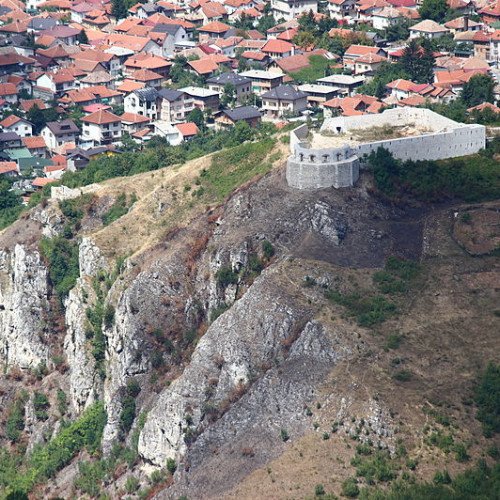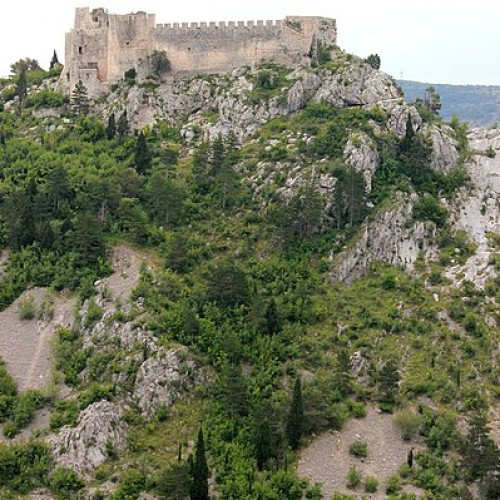Castles of "Bosnia and Herzegovina" BIJELA TABIJA vs BLAGAJ FORTRESS

BIJELA TABIJA
The White Fortress (Bosnian-Croatian-Serbian: Bijela Tabija / Бијела Табија) is an old fort overlooking the historic core of Sarajevo. It is a national monument of Bosnia and Herzegovina. Bijela Tabija is 667 metres (2,188 ft) above sea level. Bijela Tabija is a protruding part of the wall of what was historically known as the old Vratnik City, and dominates the Eastern, the natural entrance to Sarajevo. It is built of stone and it used to house a gun-crew and an ammunition storage. Its thick walls have openings for cannons. As far as the precise year of construction goes, differing opinions have been put forward. One of them proposes that Bijela Tabija was built around 1550 (this opinion is founded on the information given by the travel writer Katarino Zeno) and was destroyed during the time of Vratnik City's construction when a new fort was erected in its place. According to another opinion, a fortress existed in the place of Bijela Tabija during the Middle Ages and it was not bigger than the usual medieval defence fortresses that protected open settlements in their vicinity. Since it is confirmed that there was a medieval settlement Tornik on the site of today's Sarajevo, it is safe to presume that this settlement must have had a fort which protected it. Bijela Tabija's location which overlooks the entire Sarajevo valley is ideal for situating a mediaeval fortress. It was a fortress with a rectangular base, accompanied with four square-based towers at each of its corners and a fifth above the entrance gate. This shape classifies it as a building from the late 14th or early 15th century, which is exactly the time when the medieval settlement on the site of today's Sarajevo is first mentioned in written documents.
Statistics for this Xoptio

BLAGAJ FORTRESS
Blagaj Fortress or Old Town of Blagaj (Bosnian, Croatian and Serbian: Stari grad Blagaj, Serbian Cyrillic: Стари Град Благај; pronounced [blaːgaj]), locally known as Stjepan-grad (Стјепан-град), or Stipan-grad, in classical times Bona (Бона), is a town-fortress complex near the town of Blagaj, Bosnia and Herzegovina. The old Blagaj Fort was built on a high, inaccessible karst hill, at an elevation of 310 metres (1,020 ft) above sea level and 266 metres (873 ft) above the source of the river Buna. Blagaj Fort is 275 metres (902 ft) above sea level. The archaeological material scattered above the slopes of Blagaj hill indicate that settlements existed here during the prehistoric and Roman periods. Remains of fortifications were discovered on each of the summit's highest points: On the north-eastern summit, there are the remains of a Roman or late antique fortification or observation post (specula, burgus) known as Mala gradina, while on the south-eastern summit the contours of a prehistoric hillfort can be discerned. The south-western summit contains the remains of the present day Stjepan grad, a medieval or Ottoman period fort. The shorter sides of the triangle are bordered by a gorge through which a river once flowed, and on the longer and only accessible side the remains of massive ramparts are visible, enclosing a fortified town complex of more than 2 hectares (4.9 acres) in area. It is possible that this complex consisted of two parts in the early medieval period – the Old Fort (Stjepan grad) and Mala gradina, and that this twin settlement lasted at least until the mid-tenth century. The earliest indirect source in writing on the Zahumlje forts, including Blagaj, is the "Treatise on Peoples" by the Byzantine Emperor and writer Constantine Porphyrogenitus, dating between 948 and 952, in which two forts are referred to – Bona and Hum.[1] After the 10th century, Blagaj played an important role in the development of Hum or Zahumlje. A major influence on its development was the proximity of a major route linking the Adriatic sea with the Bosnian hinterland via the Neretva valley (“via Narenti”). Turbulent political events, particularly after the tenth century, did not have any essential impact on the economic development of the town besides the occasional ramparts. The prince of Hum, Miroslav, held court in Blagaj (Orbini, II Regno, 350). During his time in the church of SS Cosmos and Damian was built. A plaque with an inscription in Cyrillic, found in 1912 near the ruins of the local manor of Bišća and the locality Vrači records the construction of the church (Vego, 1957, 15). The plaque is now kept in the National Museum of Bosnia and Herzegovina. By the time of King Tvrtko, Bosnian rulers were issuing charters in Blagaj, and in May 1404 Blagaj became one of the residences of Duke (vojvoda) Sandalj Hranić, and then of count (herzeg) Stjepan Vukčić Kosača, after whom the people named the fort Stjepan grad. The first written reference to it is a peace accord between Duke Sandalj Hranić and the Venetians, from November 1, 1423, issued “in our town of Blagaj”. It was also mentioned in the 15th century charters of the King of Aragon and Naples, Alphonse V. The Ottomans occupied Blagaj in 1465, and by 1473 references to the kadija of Blagaj already exist. The Ottomans repaired the fort twice: in 1699, when the west tower was repaired, and again in 1827. A garrison was stationed there until 1835, although the fort’s former strategic role had long since been taken over by Mostar.